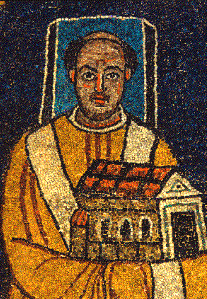
Pope Paschal I was the bishop of Rome and ruler of the Papal States from 25 January 817 to his death in 824.

The Archbasilica of Saint John Lateran is the Catholic cathedral of the Diocese of Rome in the city of Rome, and serves as the seat of the bishop of Rome, the pope. The archbasilica lies outside of Vatican City proper, which is located approximately four kilometres northwest. Nevertheless, as properties of the Holy See, the archbasilica and its adjoining edifices enjoy an extraterritorial status from Italy, pursuant to the terms of the Lateran Treaty of 1929. Dedicated to the Christ, in honor of John the Baptist and John the Evangelist, the place name, Laterano (Lateran) comes from an ancient Roman family (gens), whose palace (domus) grounds occupied the site; the adjacent Lateran Palace was the primary residence of the pope until the Middle Ages.

The Basilica of Saint Clement is a Latin Catholic minor basilica dedicated to Pope Clement I located in Rome, Italy. Archaeologically speaking, the structure is a three-tiered complex of buildings: (1) the present basilica built just before the year 1100 during the height of the Middle Ages; (2) beneath the present basilica is a 4th-century basilica that had been converted out of the home of a Roman nobleman, part of which had in the 1st century briefly served as an early church, and the basement of which had in the 2nd century briefly served as a mithraeum; (3) the home of the Roman nobleman had been built on the foundations of republican era villa and warehouse that had been destroyed in the Great Fire of AD 64.
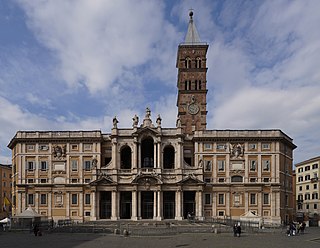
The Basilica of Saint Mary Major, or church of Santa Maria Maggiore, is a Major papal basilica as well as one of the Seven Pilgrim Churches of Rome and the largest Catholic Marian church in Rome, Italy.

The Basilica of Santa Maria in Trastevere ; English: Our Lady in Trastevere) is a titular minor basilica in the Trastevere district of Rome, and one of the oldest churches of Rome. The basic floor plan and wall structure of the church date back to the 340s, and much of the structure to 1140–43. The first sanctuary was built in 221 and 227 by Pope Callixtus I and later completed by Pope Julius I. The church has large areas of important mosaics from the late 13th century by Pietro Cavallini.

Our Mother of Perpetual Succour is a Catholic title of the Blessed Virgin Mary associated with a 15th-century Byzantine icon and a purported Marian apparition. The image has been enshrined in the Church of San Matteo in Via Merulana since 27 March 1499, and is today permanently enshrined in the Church of Saint Alphonsus of Liguori in Rome, where the novena to Our Mother of Perpetual Help is prayed weekly.
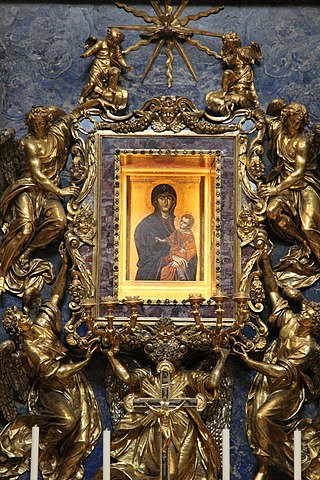
Salus Populi Romani is a Catholic title associated with the venerated image of the Blessed Virgin Mary in Rome. This Byzantine icon of the Madonna and Child Jesus holding a Gospel book on a gold ground, now heavily overpainted, is kept in the Borghese (Pauline) Chapel of the Basilica of Saint Mary Major. Pope Francis has constructed a burial vault near the icon, intended to be his final resting place.
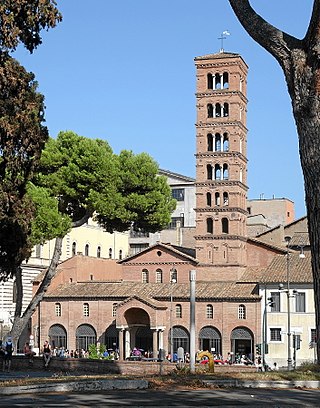
The Basilica of Saint Mary in Cosmedin is a minor basilican church in Rome, Italy, dedicated to the Virgin Mary. It is located in the rione (neighborhood) of Ripa. Constructed first in the sixth century as a diaconia (deaconry) in an area of the city populated by Greek immigrants, it celebrated Eastern rites and currently serves the Melkite Greek Catholic community of Rome. The church was expanded in the eighth century and renovated in the twelfth century, when a campanile was added. A Baroque facade and interior refurbishment of 1718 were removed in 1894-99; the exterior was restored to twelfth-century form, while the architecture of the interior recalls the eighth century with twelfth-century furnishings. The narthex of the church contains the famous Bocca della Verità sculpture.

The Basilica of San Vitale is a late antique church in Ravenna, Italy. The sixth-century church is an important surviving example of early Byzantine art and architecture, and its mosaics in particular are some of the most-studied works in Byzantine art. It is one of eight structures in Ravenna inscribed on the UNESCO World Heritage List. Its foundational inscription describes the church as a basilica, though its centrally-planned design is not typical of the basilica form. Within the Roman Catholic Church it holds the honorific title of basilica for its historic and ecclesial importance.

The Parish Basilica of Santa Maria del Popolo is a titular church and a minor basilica in Rome run by the Augustinian order. It stands on the north side of Piazza del Popolo, one of the most famous squares in the city. The church is hemmed in between the Pincian Hill and Porta del Popolo, one of the gates in the Aurelian Wall as well as the starting point of Via Flaminia, the most important route from the north. Its location made the basilica the first church for the majority of travellers entering the city. The church contains works by several famous artists, such as Raphael, Gian Lorenzo Bernini, Caravaggio, Alessandro Algardi, Pinturicchio, Andrea Bregno, Guillaume de Marcillat and Donato Bramante.

The Basilica of Saint Praxedes, commonly known in Italian as Santa Prassede, is an early medieval titular church and minor basilica located near the papal basilica of Saint Mary Major, on Via di Santa Prassede, 9/a in rione Monti of Rome, Italy. The current Cardinal Priest of Titulus Sancta Praxedis is Paul Poupard.

Santa Pudenziana is a church of Rome, a basilica built in the 4th century and dedicated to Saint Pudentiana, sister of Praxedes and daughter of Pudens. It is one of the national churches in Rome, associated with Filipinos.

Our Lady of Walsingham is a title of Mary, mother of Jesus venerated by Catholics and High Church Anglicans associated with the Marian apparitions to Richeldis de Faverches, a pious English noblewoman, in 1061 in the village of Walsingham in Norfolk, England. Lady Richeldis had a structure built named "The Holy House" in Walsingham which later became a shrine and place of pilgrimage.

The Minor Basilica of St. Mary in Domnica alla Navicella, or simply Santa Maria in Domnica or Santa Maria alla Navicella, is a Roman Catholic basilica in Rome, Italy, dedicated to the Blessed Virgin Mary and active in local charity according to its long tradition. It is one of the best examples of the Carolingian Renaissance in Rome. It has been the titular church of Cardinal Marcello Semeraro since 28 November 2020.
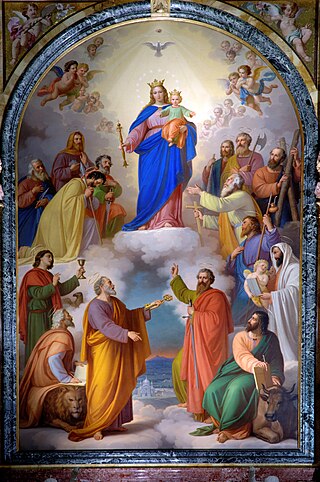
Mary, the Help of Christians is a Catholic title of the Blessed Virgin Mary, based on a devotion now associated with a feast day of the General Roman Calendar on 24 May.

Catholic Marian churches are religious buildings dedicated to the veneration of the Blessed Virgin Mary. These churches were built throughout the history of the Catholic Church, and today they can be found on every continent including Antarctica. The history of Marian church architecture tells the unfolding story of the development of Catholic Mariology.

In the liturgical traditions of the Catholic Church, the term ordination refers to the means by which a person is included in one of the holy orders of bishops, priests or deacons. The teaching of the Catholic Church on ordination, as expressed in the 1983 Code of Canon Law, the Catechism of the Catholic Church, and the apostolic letter Ordinatio sacerdotalis, is that only a Catholic male validly receives ordination, and "that the Church has no authority whatsoever to confer priestly ordination on women and that this judgment is to be definitively held by all the Church's faithful." In other words, the male priesthood is not considered by the church a matter of policy but an unalterable requirement of God. As with priests and bishops, the church ordains only men as deacons.

Panagia tis Angeloktistis or Panagia Angeloktisti is a Byzantine church located in the village of Kiti, Cyprus, roughly 12 kilometers to the southwest of modern-day Larnaka and the ancient city Kition.

Our Lady of Africa, also known as Our Mother of Africa, is a Catholic title of the Blessed Virgin Mary associated with a statue of her as a Black woman, located in the major shrine of Notre-Dame d'Afrique in Algiers, Algeria. The devotion was spearheaded by Bishop Louis-Antoine-Augustin Pavy of Algiers, who established the basilica under that title in 1856.



















